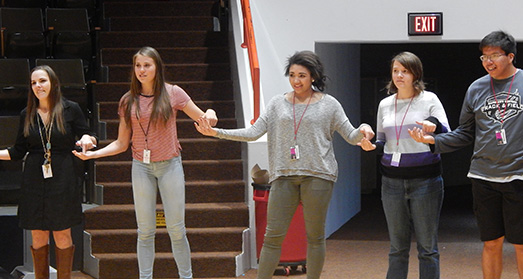
This model is designed to build a student’s connectedness by immersing them in facilitated and structured experiential learning activities that foster collaborations among the students called a Connection Mechanism. Students and staff create an environment of support that motivates personal commitment for a team culture through discussion and modeling. This immersion approach provides the opportunity to experience the activities and gain significant insight into our own values and decision-making style. Growth of the participate lives in this collaborative experience!
The Creating a System of Change Model:
- Invites all students to participate
- Has a Connection Mechanism that promotes Collaborations
- Develops Peer led programming
- Prepares the participants for growth and change
- Provides a safe environment to explore decision-making and group norms
- Develops leaders who can direct impact the school environment and community
We had great results in reducing destructive decisions in our student population by implementing a peer leader program. When the immersion activity was introduced in 2011 in which every student in our school participated in either a prevention and/or connection activity, it had significant impact. By inviting every student to participate in inclusive programming that was intentionally designed to reach every student, the foundation for systemic change was in place.
Upstream prevention techniques, which build connectedness and teach resiliency and coping skills, are the most effective method in developing a culture of support. Leadership is needed to develop these networks of support by increasing the understanding and importance of upstream prevention to our schools and communities. Creating a System of Change provides leadership and mentoring to students and adults who will develop their own programming and strategies.
The Creating a System of change model has four classifications of students:
- Sub-Cultures: Classification based on societal or sociological methods
- Affinity Groups: Students who come together for a short period of time to accomplish a goal (Clubs, Sports, Organizations)
- Isolated/Unconnected Students: Students that identify themselves as not belonging to any group
- Micro-Niches: Students that form groups within high school that may not reflect groups in society or groups after high school (Gamers or Goth)
The purpose of the Creating a System of Change model is to create long lasting and sustainable positive cultural change. Everyone wants positive change in their lives. The question is, how do we get there? An inclusive Connection Mechanism will lead to Collaborations and ultimately to positive systemic change. The Connection Mechanism allows the opportunity for all students to experience the activities and immerse themselves in the process side by side with students who are not like themselves. This is the power of the mechanism, which builds true collaborations, by inviting all students to the conversation and valuing their input.
